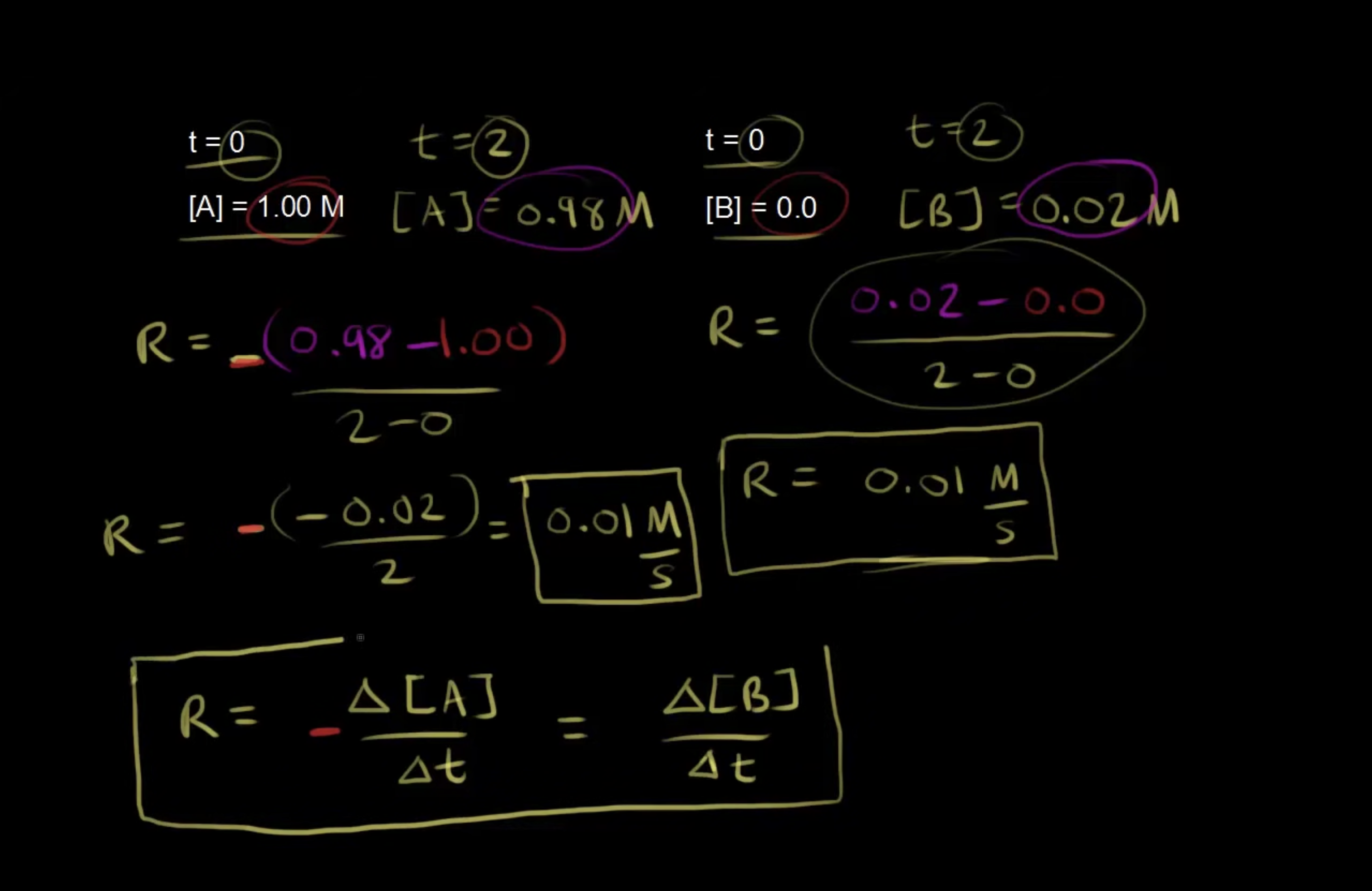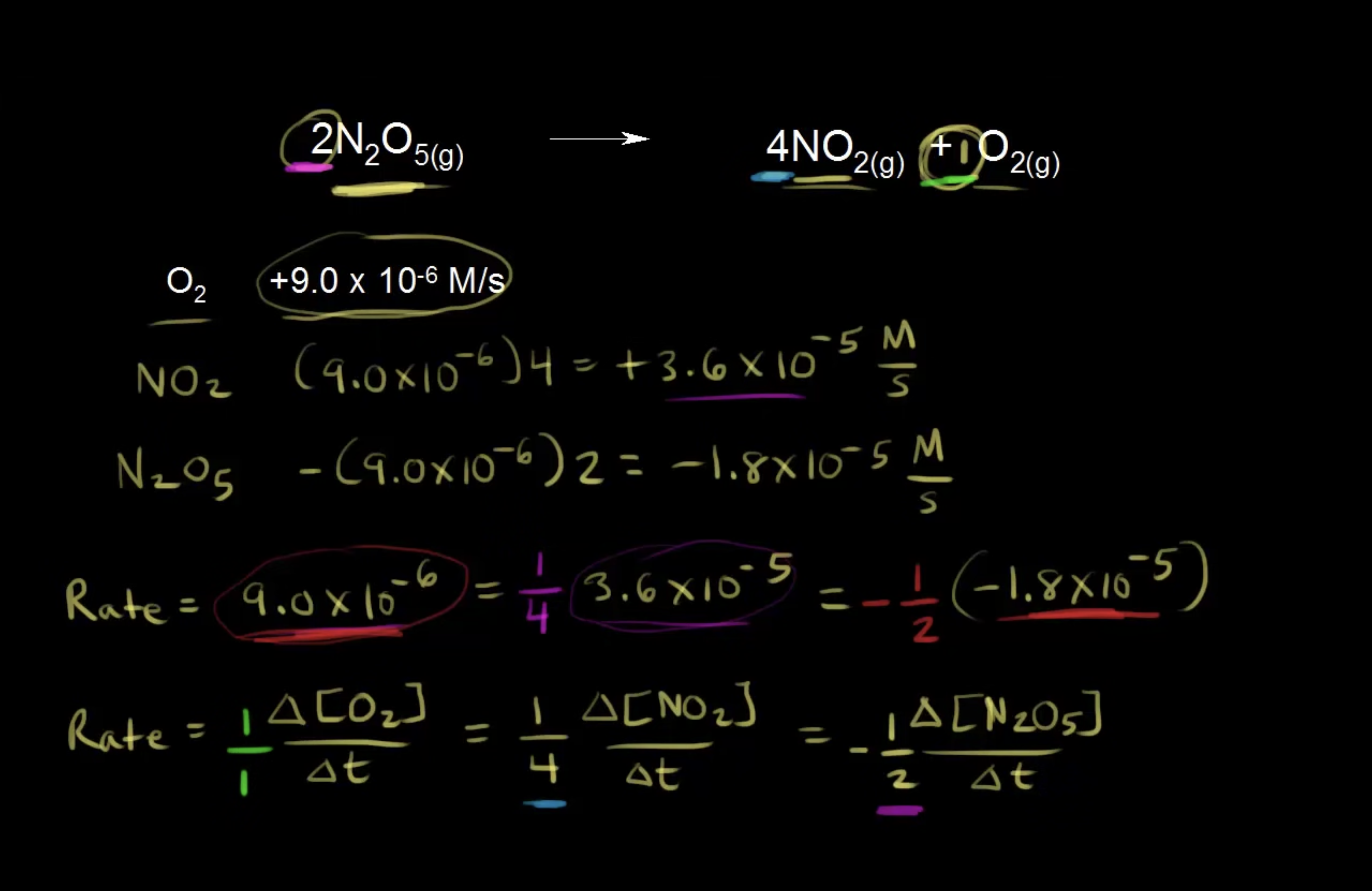AP Chem Chapter 5: Kinetics
0.0(0)
0.0(0)
New
Card Sorting
1/14
Earn XP
Description and Tags
Study Analytics
Name | Mastery | Learn | Test | Matching | Spaced |
|---|
No study sessions yet.
15 Terms
1
New cards
Rate of chemical reaction equals
change in concentration/time (basically average velocity)
Measured in M/s (moles per second)
Each species is divided by its respective coefficient
Measured in M/s (moles per second)
Each species is divided by its respective coefficient

2
New cards
If given the reaction rate of one compound in a chemical equation, you can…
Use the mole ratios of the other compounds to find the reaction rates. Remember if it is a Reactant, there is a NEGATIVE, and if it is a product, it is positive

3
New cards
Factors that affect Reaction Rate
* Reactant Concentration (M)
* Surface Area
* Temperature
* Use of catalysts/enzymes
* Surface Area
* Temperature
* Use of catalysts/enzymes
4
New cards
If given the reaction rate of different concentrations of A and B, you can determine the Rate Law with…
The formula R = k•\[A\]^x•\[B\]^y
Where R is reaction rate
k is the rate constant
x is the order of A
y is the order of B
The OVERALL order of the equation is x+y
\
To find x and y, think about what power of a number that A and B have to be multiplied by will get the result (when the opposite A or B is *held constant*)
To find the rate constant, plug in A, B and R to solve.
Where R is reaction rate
k is the rate constant
x is the order of A
y is the order of B
The OVERALL order of the equation is x+y
\
To find x and y, think about what power of a number that A and B have to be multiplied by will get the result (when the opposite A or B is *held constant*)
To find the rate constant, plug in A, B and R to solve.
![The formula R = k•\[A\]^x•\[B\]^y
Where R is reaction rate
k is the rate constant
x is the order of A
y is the order of B
The OVERALL order of the equation is x+y
\
To find x and y, think about what power of a number that A and B have to be multiplied by will get the result (when the opposite A or B is *held constant*)
To find the rate constant, plug in A, B and R to solve.](https://knowt-user-attachments.s3.amazonaws.com/07f3a8f1b9b64492a60e6fbfece4e394.jpeg)
5
New cards
Finding the Units of the rate constant
Units changed based on the rate law / order of A and B (molarity and reaction rate)
Rate of a 0 order is M/s, 1 is 1/s, 2 is 1/M•s
Manipulate the rate law formula by plugging in an M for A and B with the respective orders as well as an M/s for the reaction rate and solve using algebra
Rate of a 0 order is M/s, 1 is 1/s, 2 is 1/M•s
Manipulate the rate law formula by plugging in an M for A and B with the respective orders as well as an M/s for the reaction rate and solve using algebra
6
New cards
How to find the rate order given a Rate-Concentration Graph
If the line is…
Horizontal/flat = 0
Linear = 1
Exponential = 2
Steeper Exponential = 3
Horizontal/flat = 0
Linear = 1
Exponential = 2
Steeper Exponential = 3
7
New cards
The Integrated Rate Law for 1st order is…
ln\[A\]t = -k•t + ln\[A\]0
Also can be written as ln\[At/A0\] = -k•t using log properties
Linear/straight line (with a slope of -k and a y-intercept of ln\[A\]0)
Takes the form of y=mx+b when graphed
**Always has a negative slope**
Also can be written as ln\[At/A0\] = -k•t using log properties
Linear/straight line (with a slope of -k and a y-intercept of ln\[A\]0)
Takes the form of y=mx+b when graphed
**Always has a negative slope**
![ln\[A\]t = -k•t + ln\[A\]0
Also can be written as ln\[At/A0\] = -k•t using log properties
Linear/straight line (with a slope of -k and a y-intercept of ln\[A\]0)
Takes the form of y=mx+b when graphed
**Always has a negative slope**](https://knowt-user-attachments.s3.amazonaws.com/e55d68ff3ff34e008de24f68c208073c.jpeg)
8
New cards
In relation to molarity, pressure has a ____ relationship
DIRECT
Using PV = nRT, you can see that P= nRT/V
Since n/V is molarity, P also equals MRT. Thus, M is directly proportional to P.
When using rate law, gases use pressure rather than concentration because it’s easier to measure
Using PV = nRT, you can see that P= nRT/V
Since n/V is molarity, P also equals MRT. Thus, M is directly proportional to P.
When using rate law, gases use pressure rather than concentration because it’s easier to measure
9
New cards
If given the time and pressure of a gas, you can find its order by…
Treating time as the x and adding a third column, which will be the natural log of P. This will be the y axis and the relationship between x and y when graphed will tell you the order.
\
To find the rate constant, find the slope of the line.
\
To find the rate constant, find the slope of the line.

10
New cards
Half life of a first-order reaction.
Rewriting the integrated gas law as \[A\]t = \[A0\]•e^-kt, we can graph the equation like exponential decay.
Manipulating the formula and taking the natural log of 1/2, you get half life = .693/k
Manipulating the formula and taking the natural log of 1/2, you get half life = .693/k
11
New cards
Integrated Rate Law for Second Order
You know that the reaction is second order if it forms a linear relationship when time is graphed against 1/M. Slope is really 2k since it is second order.
**Always has a positive slope**
**Always has a positive slope**

12
New cards
Integrated Rate Law for Zero Order
Zero order if straight line when time is graphed against \[A\]0
A zero order reaction means that increasing concentration has NO effect on reaction rate.
**Always has a negative slope**
A zero order reaction means that increasing concentration has NO effect on reaction rate.
**Always has a negative slope**
13
New cards
If the coefficient in front of A is not one…
the slope becomes x•k, where x is the coefficient of A
14
New cards
In terms of reaction order, radioactive decay is…
A FIRST order reaction
15
New cards